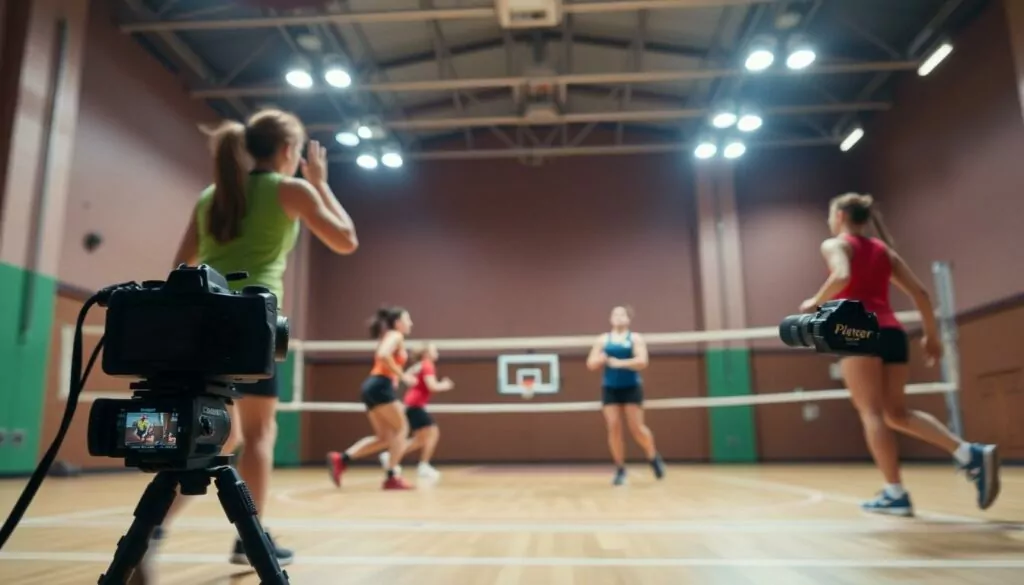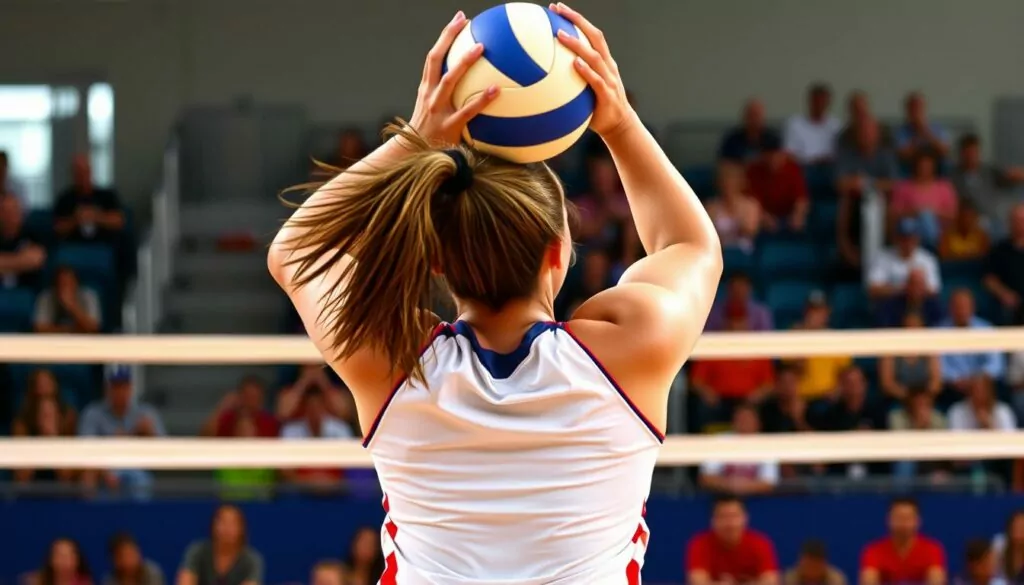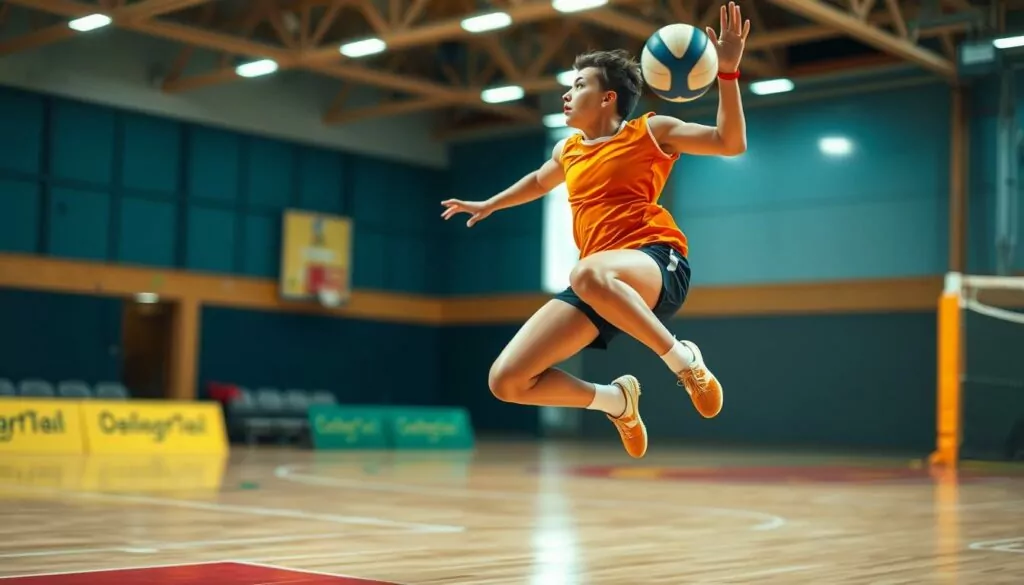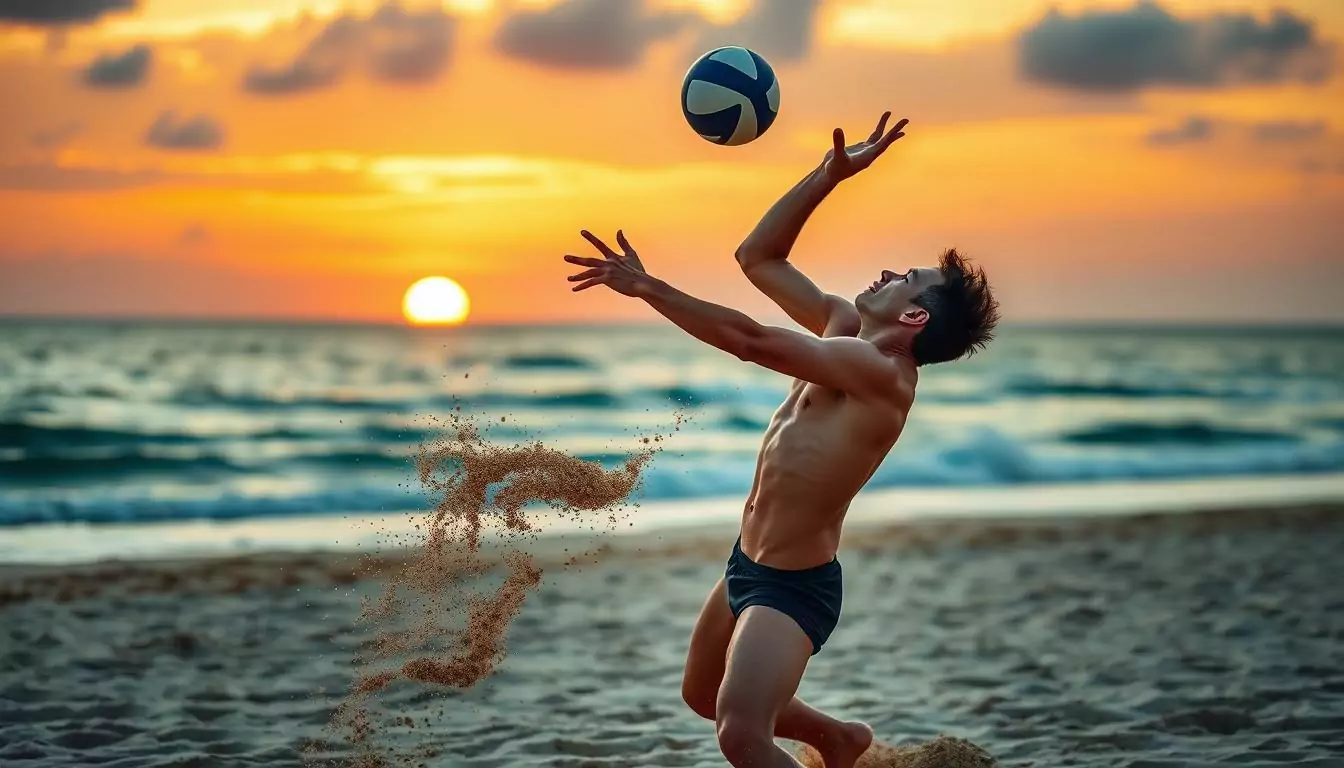Volleyball photography blends excitement with challenge. It requires skill and preparation to capture fast-paced action in indoor settings. Success depends on understanding the sport and mastering your equipment.
Indoor volleyball shots need specific sports photography techniques. You must handle quick ball movements and net interference while maintaining focus. Positioning is crucial for dynamic plays.
Prime spots include behind the service area, in stands above the net, or at the attack line. These vantage points offer excellent opportunities to capture exciting moments.
Versatile lenses are essential for volleyball photography. A 24-70mm f/2.8 lens works well for wide game shots. For detailed action from afar, use a 70-200mm f/2.8 zoom lens.
Want to add creativity? Try a 16-35mm wide-angle or 300mm prime lens. These options can help you capture unique perspectives of the game.
Key Takeaways
- Master high shutter speeds to freeze fast-moving action
- Position yourself strategically around the court for varied perspectives
- Invest in versatile lenses for different shot types
- Understand the game to anticipate key moments
- Experiment with angles to capture engaging action shots
- Adapt to low-light conditions in indoor gyms
Essential Equipment for Volleyball Photography
The right gear is crucial for capturing perfect volleyball shots. Good equipment helps freeze fast-paced action in tricky indoor lighting. Your gear choice can make a big difference in photo quality.
Camera Bodies: Features to Look For
Choose cameras with great low-light performance and quick autofocus for volleyball photography. The Fujifilm X-T30 II offers a 30 fps electronic shutter in cropped mode. This feature is perfect for catching quick plays on the court.
| Camera Model | Key Features |
|---|---|
| Fujifilm X-T30 II | 30 fps electronic shutter (cropped mode) |
| Sony A6000 | 11 fps, ISO 100-25,600, Full HD 60p video |
| Panasonic Lumix G9 II | 75 fps, 5.7K 60p video recording |
| Nikon Coolpix P950 | 15 fps, 24-2000mm equivalent zoom |
Lenses: Prime vs. Zoom for Indoor Courts
Lens choice is key for volleyball photography. A 24-70mm lens works well for net-side shots. An 85mm prime can be great for small gym spaces.
Consider these options for best results:
- 24-70mm f/2.8: Versatile for various court positions
- 70-200mm f/2.8: Excellent for capturing distant action
- 85mm f/1.4: Ideal for low-light conditions and portraits
Accessories: Monopods and Memory Cards
Don’t forget important accessories. A monopod helps steady long lenses in dim gyms. Fast, high-capacity memory cards are vital for non-stop shooting.
Mastering camera settings is crucial. Use at least 1/1200 shutter speed for high school or college games. This helps freeze the action.
Try single-point tracking and back-button focus. These techniques improve subject tracking during intense volleyball rallies.
Mastering Camera Settings for Indoor Volleyball

Indoor volleyball photography requires precise camera settings. These settings help capture fast-paced action in challenging lighting conditions. Mastering them allows you to freeze motion and produce sharp, vibrant images.
Optimal Shutter Speed for Freezing Action
To freeze volleyball action, set your volleyball shutter speed to at least 1/500s. For high school and college matches, aim for 1/1200s or higher. This rapid shutter speed stops motion, ensuring crisp images of players.
Aperture and Depth of Field Considerations
Use a wide aperture like f/2.8 or f/4 to let in more light. This setting helps isolate players from the background. For wider court views, consider f/8 to keep more of the scene in focus.
ISO Management in Low-Light Gyms
Indoor sports photography often requires high ISO settings. Start with ISO 3200 and adjust as needed. Balance image brightness with acceptable noise levels.
Modern cameras can handle ISO 6400 or higher while maintaining good image quality.
| Setting | Recommended Range | Purpose |
|---|---|---|
| Shutter Speed | 1/500s – 1/1200s+ | Freeze action |
| Aperture | f/2.8 – f/8 | Control light and depth of field |
| ISO | 3200 – 6400+ | Brighten image in low light |
Try these camera settings to find the right balance for your volleyball shots. Practice is key in sports photography. Keep shooting and fine-tuning your technique to capture winning court moments.
Volleyball Photography: Capturing the Perfect Action Shot
Volleyball photography requires a sharp eye and perfect timing. The court brims with energy, offering many chances for dynamic images. Your aim is to freeze those crucial game-defining moments.
For crisp volleyball shots, use a high shutter speed of 1/1600. This keeps the ball sharp in your photos. A speed of 1/800 can add artistic blur if desired.
Most volleyball matches happen in poor lighting. You’ll need to balance your camera settings carefully. Consider these settings:
Timing is key in volleyball photography. Women’s games often provide great chances for celebration shots. Use continuous shooting mode to catch these moments.
Position yourself high in the stands for clearer views. This lets you capture the entire court without obstructions. Focus on one player during each play.
| Camera | Lens | Technique |
|---|---|---|
| Nikon D500 | 400mm | Continuous shooting |
| High ISO capability | Fast aperture | Player tracking |
| Burst mode | Image stabilization | High angle shooting |
These tips will help you capture stunning volleyball action shots. They’ll showcase the sport’s intensity and athleticism. Happy shooting!
Positioning and Angles for Dynamic Volleyball Photos

Mastering volleyball photography angles is key to capturing stunning action shots. Understanding net photography techniques will help you create standout images. Your game will improve as you learn these skills.
Shooting from Behind the Service Area
The service area is prime for capturing net action. Position yourself off-center for better framing and to avoid blocking players. This angle captures serves, blocks, and spikes clearly.
Elevated Perspectives: Utilizing the Stands
Shooting from the stands offers unique volleyball photography angles. Aim above the net to capture the full court and player movements. This spot is great for wide-angle shots and team formations.
Capturing Action at the Attack Line
The attack line is perfect for dynamic volleyball photos. Focus on digs, defensive plays, and player reactions. Use portrait orientation and lower focus points to reduce net interference.
| Shooting Position | Best For Capturing | Recommended Lens |
|---|---|---|
| Behind Service Area | Serves, Blocks, Spikes | 70-200mm f/2.8 |
| Elevated in Stands | Full Court, Team Formations | 24-70mm f/2.8 |
| At Attack Line | Digs, Defensive Plays | 70-300mm |
Use a fast shutter speed of at least 1/500th second to freeze action. Try different court positions to get diverse shots throughout the match. These techniques will help you create compelling images that bring the game alive.
Post-Processing Techniques for Volleyball Images

Post-processing can boost your volleyball photo quality. Start by managing noise in high ISO shots. Modern cameras handle low light well, but noise reduction software is still crucial.
Cropping helps improve volleyball photo composition. It lets you focus on key elements and perfect your framing. White balance tweaks may be needed, though auto settings often work well.
Boost contrast and sharpness to make action stand out. This is vital for volleyball shots with quick movements. Shoot wider during games for more cropping options later.
| Post-Processing Step | Purpose | Tip |
|---|---|---|
| Noise Reduction | Clean up high ISO images | Use software like Topaz DeNoise |
| Cropping | Improve composition | Focus on key action elements |
| White Balance | Correct color temperature | Fine-tune if auto WB falls short |
| Contrast/Sharpness | Enhance image pop | Adjust carefully to avoid artificiality |
These techniques will transform good volleyball shots into great ones. Subtle adjustments often work best. They keep the action real while making photos more appealing.
Conclusion: Elevating Your Volleyball Photography Game
Capturing great volleyball shots takes practice and dedication. Learn the sport well to anticipate the action on the court. Master your sports camera focus to freeze intense moments.
Find strategic spots along the sidelines or end line. Mix up your approach by tracking the ball and focusing on players. This variety helps tell the complete story of the match.
Lighting and composition are key for impactful images. Use the “Rule of Thirds” to frame subjects effectively. Adjust your camera settings for indoor gym conditions.
With time, you’ll develop an instinct for capturing split-second plays. Respect the space of players and officials while shooting. Your images will bring the intensity of volleyball to life.
FAQ
What equipment is essential for volleyball photography?
Key lenses for volleyball photography are 24-70mm f/2.8 and 70-200mm f/2.8. Optional lenses include 16-35mm f/2.8 and 300mm f/2.8 for more options. Choose camera bodies with good low-light performance and quick autofocus.
What camera settings should I use for indoor volleyball?
Use manual settings with auto ISO for flexibility. Set shutter speeds to at least 1/500s, ideally 1/1200s or higher. Use high-speed shutter and single-point tracking focus.
Keep the aperture wide to let in more light. Be ready to use higher ISO settings in dim lighting.
What should I focus on when capturing volleyball action shots?
Pay attention to focus, ball, and eyes in your shots. Images without the ball are often less compelling. Capturing emotions can be impactful too.
Be patient when trying to photograph diving players. These shots are harder to get.
What are the best positions and angles for volleyball photography?
Shoot from behind the service area for great net action shots. Try shooting from above the net in the stands.
The attack line is perfect for capturing digs, defensive plays, and player reactions.
How can I improve my volleyball photography post-processing?
Use noise reduction software like Topaz DeNoise for high ISO images. Be careful not to make images look artificial.
Crop photos to enhance composition and highlight key elements. Adjust white balance if needed, but auto often works well. Boost contrast and sharpness to make action stand out.
What are some tips for successful volleyball photography?
Success in volleyball photography comes with patience, practice, and game knowledge. Shoot often and try new techniques to improve.
Respect players, coaches, and referees while finding the best angles. Capture both action and emotion to tell the full story.
